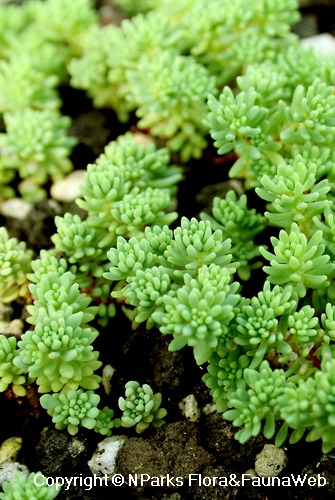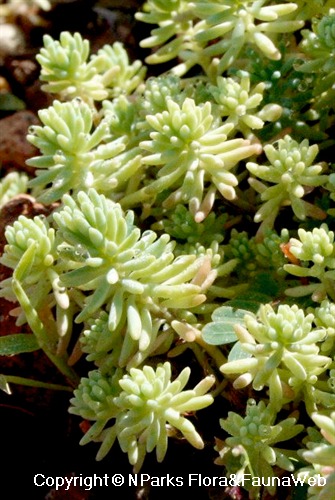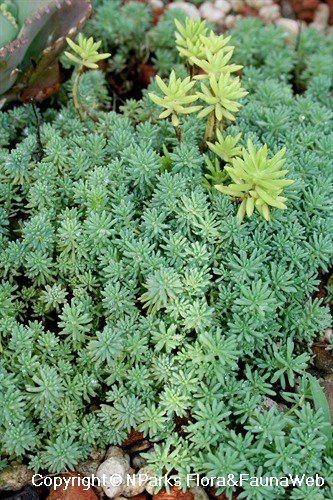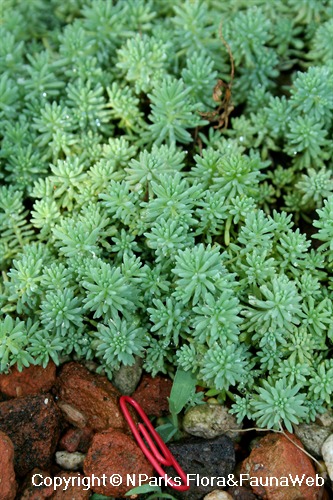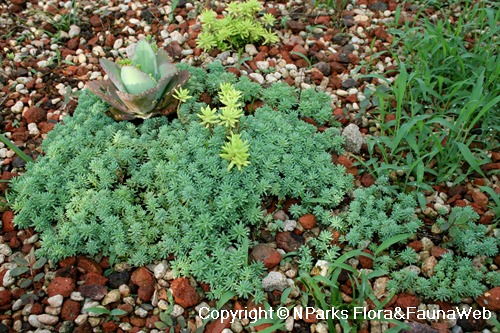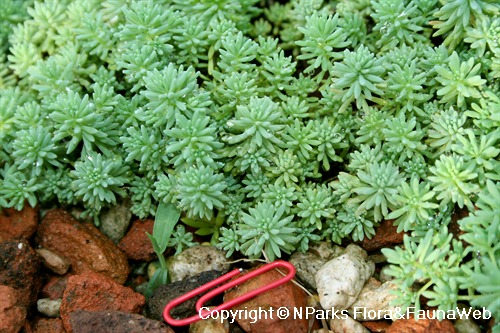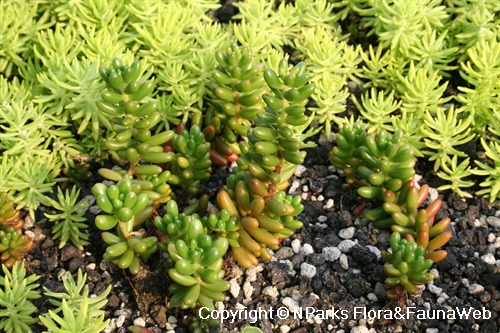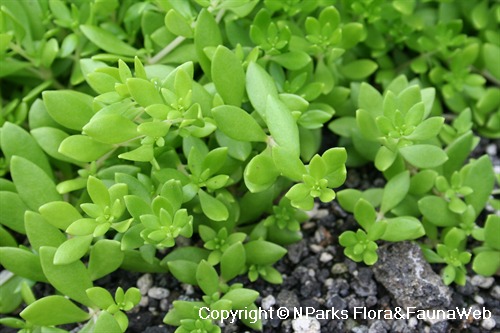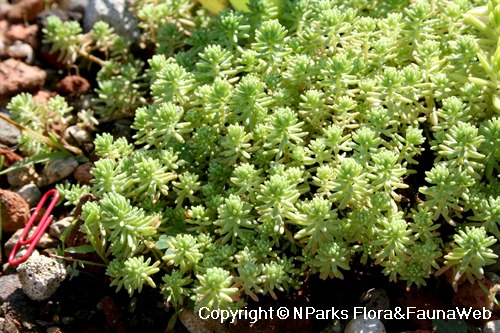
Back
Sedum sexangulare L.
| Family Name: | Crassulaceae |
| Synonyms: | Sedum montenegrinum, Sedum mite, Sedum boloniense |
| Common Name: | Tasteless Stonecrop, Six-sided Stonecrop, Watch-chain Sedum, Goldmoss Stonecrop, Insipid Stonecrop, 六楞景天 |
Name
Classifications and Characteristics
| Plant Division | Angiosperms (Flowering Seed Plants) (Dicotyledon) |
|---|---|
| Plant Growth Form | Creeper, Herbaceous Plant |
| Lifespan (in Singapore) | Perennial |
| Mode of Nutrition | Autotrophic |
| Plant Shape | Dwarf |
| Maximum Height | 0.05 m to 0.10 m |
| Maximum Plant Spread / Crown Width | 0.2 m to 0.3 m |
Biogeography
| Native Distribution | Western to Central Europe |
|---|---|
| Preferred Climate Zone | Temperate, Mediterranean |
Description and Ethnobotany
| Growth Form | Herbaceous succulent shrub, creeping by stolons to form low loose mats up to 10cm height. |
|---|---|
| Foliage | Leaves oblong-cylindrical, fleshy, spiral around stems in ranks of 6, turn from green to coppery-red under intense; dead leaves may persist on lower stems. |
| Flowers | Yellow, produced in clusters of 3 -4 branches, not observed in Singapore. |
| Similar | Resembles Sedum acre' in appearance and habit, except that the leaves are not acrid in the morning, hence its common name 'Tasteless Stonecrop'. |
| Cultivation | Prefers well-drained soils. Propagate by stem cuttings or division in moist porous media. Appears to be slower-growing than other mat-forming Sedum species used in Singapore. |
| Etymology | Genus epithet 'Sedum' derived from Latin word for 'sit', describing how some species of this genus grow attached to rocks and walls. Species epithet 'sexangulare' means 'with 6 angles', a reference to the 6-ranked spirals of the plant's leaves. |
Landscaping Features
| Desirable Plant Features | Ornamental Foliage |
|---|---|
| Landscape Uses | Suitable for Rooftops, Vertical Greenery / Green Wall, Flowerbed / Border, Container Planting |
| Thematic Landscaping | Rockery / Desert Garden |
Fauna, Pollination and Dispersal
| Seed or Spore Dispersal | Abiotic (Explosive Dehiscence) |
|---|
Plant Care and Propagation
| Light Preference | Semi-Shade, Full Sun |
|---|---|
| Water Preference | Little Water |
| Plant Growth Rate | Fast |
| Rootzone Tolerance | Well-Drained Soils, Poor Infertile Soils, Shallow Media, Disease / Pest Resistant, Drought Tolerant |
| Maintenance Requirements | Low |
| Propagation Method | Seed, Stem Cutting |
| Planting Distance | 0 to 0 |
Foliar
| Foliage Retention | Evergreen |
|---|---|
| Mature Foliage Colour(s) | Green |
| Mature Foliage Texture(s) | Smooth, Thick |
| Foliar Type | Simple / Unifoliate |
| Foliar Arrangement Along Stem | Spiral |
| Foliar Shape(s) | Non-Palm Foliage (Oblong) |
| Foliar Margin | Entire |
| Foliar Apex - Tip | Acute |
| Typical Foliar Area | Nanophyll ( 0.25cm2 - 2.25 cm2 ) |
| Leaf Area Index (LAI) for Green Plot Ratio | 4.5 (Shrub & Groundcover - Dicot) |
Non - Foliar and Storage
| Stem Type & Modification | Herbaceous |
|---|---|
| Root Type | Underground (Fibrous Root) |
| Specialised Storage Organ(s) | Aboveground |
Floral (Angiosperm)
| Flower & Plant Sexuality | Bisexual Flowers |
| Flower Colour(s) | Yellow / Golden |
|---|---|
| Flower Symmetry | Radial |
| Inflorescence Type | Cyme |
| Flowering Habit | Polycarpic |
| Flowering Period Remarks | Blooms in mid-summer in seasonal climates. |
Fruit, Seed and Spore
| Fruit Classification | Simple Fruit |
|---|---|
| Fruit Type | Dehiscent Dry Fruit , Follicle |
Image Repository
Others
| Master ID | 1156 |
|---|---|
| Species ID | 2449 |
| Flora Disclaimer | The information in this website has been compiled from reliable sources, such as reference works on medicinal plants. It is not a substitute for medical advice or treatment and NParks does not purport to provide any medical advice. Readers should always consult his/her physician before using or consuming a plant for medicinal purposes. |


